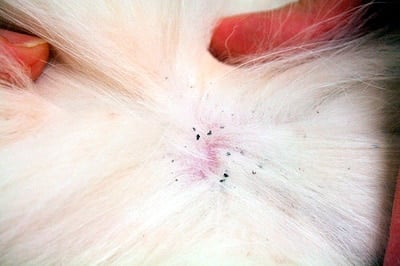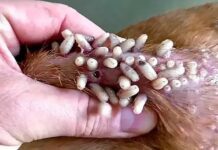One of the most feared parasites by dog owners are fleas, small parasites that feed on the blood they suck when they bite. Fleas are very common on dogs – it’s unusual to find a dog who has never had them before, or who doesn’t currently have them. They aren’t dangerous for humans but they are irritating and in some cases can transmit certain diseases.
If you notice that your dog is scratching intensely and often, or if you feel little bites on his back or tail, it’s possible that he has a flea that’s making him itch. Don’t worry, fleas are easy to get rid of if you follow the right steps, both in adult dogs and puppies.

What is a flea?
A flea is a parasitic insect as you can see in the picture above, which measures from one to four millimeters long. They have a life cycle of about four weeks, and during this time they lay around 40 eggs per day, causing them to reproduce at an incredible rate; in just a few days they can create an immense colony, according to Wikipedia. Fleas don’t just lay eggs on the host (your dog, in this case), but they can also lay them on the bed, couch, between carpet fibers… anywhere with a warm temperature.
There are more than 2000 different species of fleas, with the variety “Ctenocephalides felis felis” being the most common in dogs as well as cats. They feed on our pets’ blood, sucking it up and creating irritation, itching and dermatological problems. Some dogs even develop allergies to these bites, as they are really bothersome and irritating.
Although they normally don’t transmit diseases, it’s true that fleas can transmit some dangerous diseases, like bubonic plague or typhus, although this happens in only very rare cases. In general a flea won’t use a human as a host if there is a dog available, since the large amount of hair on dogs gives them the perfect refuge to live and reproduce.

Why does my dog have fleas?
Dogs with weakened defenses or who are a bit sick are more prone to getting fleas than healthy dogs, which is where the Spanish saying “on a skinny dog, everything turns to fleas” comes from. If you take your dog to walk in the country, in places that aren’t very clean or where livestock have been (sheep, cattle, horses, etc.) it’s likely that your dog will easily pick up a flea or two.
Healthy dogs can also get fleas. Often, they play with other dogs who have fleas and they spread immediately. A flea can jump nearly 12 inches, making it easy for them to hop from one dog to another.
Dogs with poor hygiene are the most susceptible to fleas. If they aren’t bathed when they need to be or don’t have the right protection, like flea pipettes for dogs, they’re an easy target for fleas. Don’t miss: What is the best pipette for a dog?
Don’t worry if your dog has caught fleas; it’s not his fault and there is a solution. The first thing you have to do is determine if he has fleas. Use your hands to spread his fur apart, gently and without hurting him, all you want to do is look. If you see tiny bugs that are black or brown, about the size of the head of a pin, moving around in his fur, he has fleas.
The best places to look for fleas are very accessible. For example, your dog’s back, belly, neck and head. If you find just a single flea, you should apply the proper treatment to eradicate them now since just one flea can lay up to 40 eggs per day, which in 15 days will be 40 new adult fleas.

How to get rid of fleas?
Treatments to get rid of fleas from your dog and your home are very effective. These days, there is a whole range of products that make the task of eliminating fleas much easier, and we also recommend you keep in mind the classic home remedies to get rid of fleas.
Remember to follow these tips also and you’ll soon enjoy a flea-free dog.
- The first thing you should do is maintain a strict hygiene, both at home and on your pet himself. Wash your dog with a special anti-flea shampoo, which can be found at any veterinary clinic. Repeat this bath 15 days from now and from then on, once per month.
- Throw out your dog’s bed and buy a new one, thereby eliminating any eggs that could be in his bed. You can also wash it in the washing machine at the hottest temperature, which will eliminate the existing fleas (if possible, add a little bleach to the wash).
- Wash the places where your dog tends to play or sleep, the places where he tends to hang out at home, with water and bleach to eliminate any possible flea eggs or larvae.
- After your dog’s bath, wait 48 hours and then apply an anti-flea pipette, which you can find at the vet’s office or pet store. These pipettes last one month, so you need to apply a new one every month, always two days after washing him.
- There are also collars you can use which repel fleas and ticks and help keep your dog from catching them. These collars usually last between two and four months, depending on the brand and composition.

For the most difficult cases, where a dog may be infested with hundreds upon hundreds of fleas, there are also special pills to get rid of fleas. They are sold in veterinary clinics, you give them to your dog with food and in a short while all the fleas will have disappeared. However, we only recommend these pills for very extreme cases. Their effect isn’t permanent, far from it, and you’ll have to supplement their effect with anti-flea pipettes and collars.
How to get rid of fleas on a puppy?
Puppies are much more sensitive than adult dogs, which is why often (most of the time, in fact) you can’t use the highly effective anti-flea pipettes or collars. But don’t worry, it’s very simply to get rid of fleas on your dear little puppy.
They sell a special flea spray for puppies in veterinary clinics. It’s a very gentle poison that you can spray on your puppy. Then, rough up his fur a bit with your hands so that the poison goes down to the root of the hair and kills all the fleas he’s carrying.
You shouldn’t let your puppy’s fleas go untreated, since they’re immune system isn’t fully developed and they can get serious dermatological problems, aside from catching other diseases.

Can fleas on a dog affect humans?
Usually they won’t – they prefer to live on dogs. Dog’s large amount of fur makes them a fantastic place for fleas to live, while humans on the other hand hardly have any hair. Now, that doesn’t mean you won’t get bitten by a flea… Generally, you’ll notice that you have three little bites all together. When fleas bite a human, they usually do it in sets of three bites, so it’s very easy to tell if the bite you have is from a flea or a mosquito.
Besides that, you’ll usually notice some irritation in each of the bites. If there are several fleas, you’ll notice that from one day to the next you’ll have dozens of new bites; it’s very simple to detect them from their bites.
Getting rid of them is just as easy as for dogs. A complete bath with an anti-flea gel, which you can buy at the pharmacy, and some pills that your doctor will prescribe, will be more than enough to do away with the fleas that you’ve managed to catch. You’ll have to clean the house of course – washing the sheets and sofa is essential.

Tips to eradicate fleas
- Forget about natural remedies like eucalyptus or lavender oil, they only work as preventatives. When fleas have already put up shop, you have to use specific “chemical” products, which will give you the best results.
- An ounce of prevention is worth a pound of cure. The best way to keep your dog from getting fleas is to prevent them. A monthly bath with an anti-parasite shampoo, a monthly pipette and a good flea collar will be more than enough to keep your dog from getting any fleas.
- If your dog lives in the yard, there are powders and other products that you can use to spray his house and nearby, thereby eliminating any flea or dangerous insects for your dog. Add this to the preventive measures mentioned above to be safe.
- Don’t take your dog walking by dumps, dirty places or places where there are livestock (sheep, cattle, horses, etc.). By avoiding walking through possible infestation sites, you’ll be halfway there.
- Fleas are insects, like head lice in children. Don’t get mad at your dog for getting fleas; it’s your fault after all for not preventing them. Getting rid of them is simple and in a few days you’ll have done away with the fleas, so take it easy.
- Don’t use insecticides all over the house to kill bugs. Many insecticides are dangerous for your dogs, and they can even poison them!





